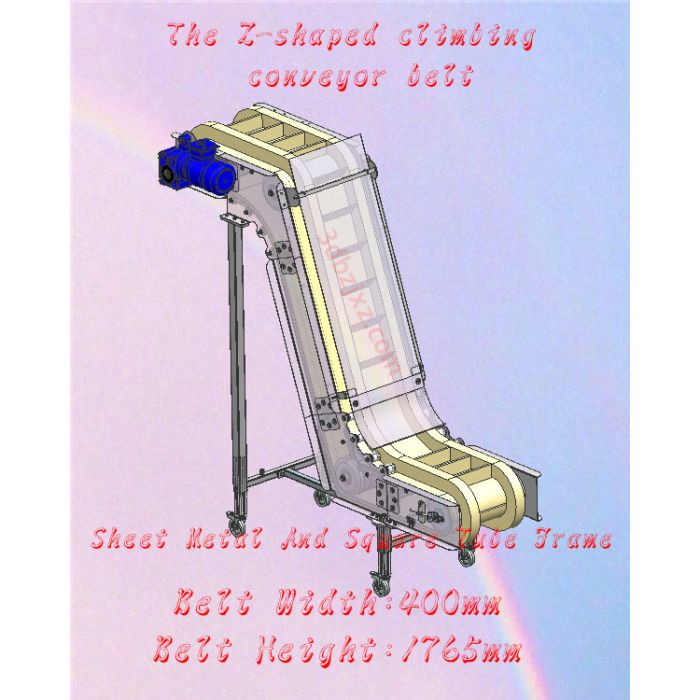BeltConveyor_W400_H1765
- Stp samples download
- click to down
试用数据点击上方下载!
The Z-shaped climbing conveyor belt, also known as the Z-shaped hoist, is mainly composed of a transmission device, conveyor belt, support device, and feeding port. The main design points include the following aspects:
1、 Transmission device design
The transmission device is a key component that drives the movement of the conveyor belt, and its performance directly affects the operating efficiency of the hoist. Therefore, in the design, it is necessary to select transmission devices with stable performance and high efficiency, such as using advanced reducers and motor combinations, to improve transmission efficiency. At the same time, the layout of the transmission device should be reasonably optimized to reduce energy loss and improve overall operational efficiency.
2、 Conveyor belt design
The conveyor belt is the part of the hoist that comes into direct contact with the material, and its performance has a significant impact on the operational efficiency of the hoist. In design, high-strength and wear-resistant materials should be selected to make conveyor belts to improve their service life. At the same time, optimize the shape and structure of the conveyor belt to better meet the conveying needs of materials, reduce material slippage and blockage during the conveying process, and improve conveying efficiency.
3、 Support device design
The supporting device is an important guarantee for the stable operation of the hoist. In the design, it is necessary to arrange and reinforce the supporting devices reasonably to improve their load-bearing capacity. At the same time, advanced shock absorption technology and buffering devices are adopted to reduce vibration and impact during equipment operation, improve equipment stability and service life.
4、 Feed inlet design
The feed inlet is the entrance for materials to enter the elevator, and its design directly affects the efficiency of material transportation. In the design, adjustable feed inlet design can be adopted to meet the needs of different materials and conveying volumes. At the same time, optimize the shape and size of the feeding port to reduce material scattering and blockage during the feeding process, and improve material conveying efficiency.
5、 Structural layout design
The structural layout design of Z-type hoist is also crucial. Usually, the side panels of a Z-type hoist include a lower horizontal section, a sloping section, and an upper horizontal section that are sequentially connected. When designing, it is necessary to ensure smooth connections between these sections to reduce resistance and loss of materials during transportation. At the same time, it is necessary to consider the tension and adjustment method of the conveyor belt to ensure that it maintains appropriate tension during operation, avoiding deviation and damage.
6、 Other design points
Considering the state and loading and unloading conditions of materials during transportation, auxiliary devices such as funnels can be installed in the lower horizontal section to avoid material scattering and reduce transportation efficiency.
Install support devices such as rollers between the inclined section and the upper horizontal section to ensure the stability and load-bearing capacity of the conveyor belt during the climbing process.
According to different unloading environments and usage requirements, select suitable accessories such as headstock, support legs, and convex arc rack to improve the adaptability and flexibility of the equipment.
In summary, the design points of Z-shaped climbing conveyor belt involve multiple aspects such as transmission device, conveyor belt, support device, feed inlet, structural layout, as well as other auxiliary devices and accessories. In the design, it is necessary to comprehensively consider these factors to ensure that the Z-type hoist has efficient, stable, and reliable performance.
Z形爬升输送带,即Z型提升机,主要由传动装置、输送带、支撑装置和进料口等部分组成。其设计要点主要包括以下几个方面:
一、传动装置设计
传动装置是驱动输送带运动的关键部件,其性能直接影响到提升机的运行效率。因此,在设计中需要选用性能稳定、效率高的传动装置,如采用先进的减速器和电机组合,以提高传动效率。同时,对传动装置的布局进行合理优化,以减少能量损耗,提高整体运行效率。
二、输送带设计
输送带是提升机与物料直接接触的部分,其性能对提升机的运行效率有着重要影响。在设计中,应选用高强度、耐磨损的材料制作输送带,以提高其使用寿命。同时,对输送带的形状和结构进行优化,使其更适应物料的输送需求,减少物料在输送过程中的滑落和堵塞现象,提高输送效率。
三、支撑装置设计
支撑装置是提升机稳定运行的重要保障。在设计中,需要对支撑装置进行合理布局和加固,以提高其承载能力。同时,采用先进的减震技术和缓冲装置,以减少设备运行过程中的振动和冲击,提高设备的稳定性和使用寿命。
四、进料口设计
进料口是物料进入提升机的入口,其设计合理与否直接影响到物料的输送效率。在设计中,可以采用可调节的进料口设计,以适应不同物料和输送量的需求。同时,优化进料口的形状和尺寸,以减少物料在进料过程中的散落和堵塞现象,提高物料的输送效率。
五、结构布局设计
Z型提升机的结构布局设计也至关重要。通常,Z型提升机的机身侧板包括依次衔接的下水平段、斜坡段和上水平段。在设计时,需要确保这些段之间的连接顺畅,以减少物料在输送过程中的阻力和损失。同时,还需要考虑输送带的张紧度和调整方式,以确保输送带在运行过程中保持适当的张紧度,避免跑偏和损坏。
六、其他设计要点
- 考虑到物料在输送过程中的状态和装卸条件,可以在下水平段安装漏斗等辅助装置,以避免物料撒料降低输送效率。
- 在倾斜段与上水平段之间设置托辊等支撑装置,以确保输送带在爬坡过程中的稳定性和承载能力。
- 根据不同的卸载环境和使用需求,选择合适的头架、支腿和凸弧段机架等附件,以提高设备的适应性和灵活性。
综上所述,Z形爬升输送带的设计要点涉及传动装置、输送带、支撑装置、进料口、结构布局以及其他辅助装置和附件的多个方面。在设计中需要综合考虑这些因素,以确保Z型提升机具有高效、稳定、可靠的性能。

